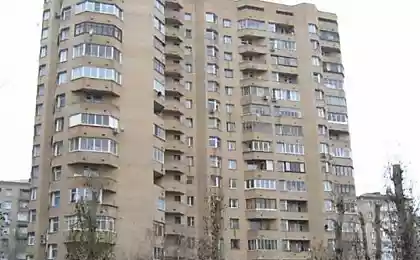1503
Social housing in the US
America could be quite different, if successfully ended a terrible experiment in building residential districts in the style of Soviet mnogoetazhya. The idea that anyone should live somewhere, is hardly new. The ancient Athenians painfully solved the problem of housing for the poor, and, admittedly, since humanity is not so far advanced in this matter. Only in the XX century, with the rapid growth of population, everyone's right to a roof over their head were recorded in most constitutions. And, as usual, there were many adventures.
One of the world's pioneers in the field of mass construction of public housing for the poor were the United States. There is already in the XIX century began to create programs of housing assistance, but the case took seriously only after the Great Depression. President Roosevelt in his "New Deal" paid special attention to the construction of social housing, and in the first half of the 30s, hundreds of thousands of square meters have been made available to the poor - for a nominal rent.
I must say that houses Roosevelt turned out very nice. It was a single family kottedzhiki three or four rooms, with palisadnichkom and backyard, with hot water and a bathroom. They cost a mere penny. To be eligible for social housing rent family had to provide evidence of its complete eradication. Small clerks and well-paid workers wept tears of blood: they were too rich to live there! As a result, an employee or a miner to pay twice as much for the broken-down apartment with a sink on the floor, and the unemployed in this time basking in the hot tub.

Yet for a long time social housing in the United States the average was much better quality housing and commercial. But, of course, at all the poor little cottage is still not enough. Therefore, in the late 40's - early 50-ies of the cottages and townhouses declined. The state began to build a huge complex of social housing - entire neighborhoods with its own infrastructure: roads, hospitals, schools, shops and, of course, high-rise buildings with comfortable and cheap apartments, where the poor devils, and began to move out of the slums.


We wanted the best
One of these systems was the grand project "Pryuit-Igou", created in St. Louis, Missouri. In 1954, he officially opened the doors to many new residents. Thirty-three eleven-house, combined in one zone with recreational green areas around, with small, but comfortable and well-equipped apartments with large areas of common use.

The architect of the project was a young, budding Japanese American Minoru Yamasaki. He has adopted the principles of Le Corbusier: modernity, functionality and comfort. The ground floors of the towers have been set aside for the joint needs of the tenants; there were cellars, bicycle storage, laundry and other services. Each floor had a long and wide gallery, which, according to the author, was to be the area of communication of residents. Here it was planned to hold a party, there were children playing in the rain, then you can just walk around, if you're tired of sitting in the four walls. Shortly before the Missouri was canceled principles of segregation (legally protected separation of white and black population), and the complex was supposed to be not only a symbol of social welfare, but also an outpost of internationalism, tolerance and brotherhood. He was given the name "Pryuit-Igou" - in honor of the hero of the Second World War, black pilot Oliver Pryuita and white member of Congress from Missouri William Igou.
He has managed the whole affair St. Louis $ 36 million - huge money at the time (you can safely multiply by twenty to understand the order of cost).
And in 1954, thousands of poor families from different slums of St. Louis entered the new lovely apartment. The rent was ridiculous. No income, of course, the project was not expected, so tenants pay only for utilities, and even then with a serious discount.
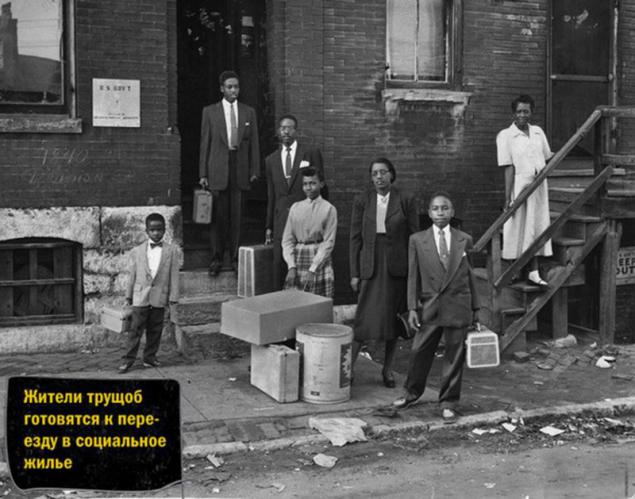
And it turned out ...
"Poverty is contagious" - also wrote Balzac, but the authors of the noble social project, it seems, never thought about the meaning of this warning. Leftist ideas already dominated the educated society, and that the poor man is certainly a victim of a brutal capitalist world, was considered axiomatic.
Feed the hungry, clothe naked, give shelter the homeless - are not these rules should not be mandatory for every decent human being? The history of the second half of the XX century, the century of great social change, has shown that these wonderful rules should be applied only as a preliminary to think about.

After complex "Pryuit-Igou" opened its doors to the poor - single mothers, the elderly lady in straitened circumstances, students from poor families - immediately found out many interesting things:
- It turns out, drinking the unemployed and single mothers are sometimes grown sons, who can not serve as an ornament of society;
- Elderly ladies who find themselves in straitened circumstances, prefer to live at least for bread for the great-nephews, even in the poorhouse, but not where the little son of a single mother zapulivaet their faces smothered by their own cat;
- Students from poor families do not like being raped in an elevator, and students prefer to learn not to lose his teeth, trying to find out who is the toughest in the stairwell.
Soon the white population left "Pryuit-Igou," and now is 99, 8% of the complex was inhabited by black tenants.
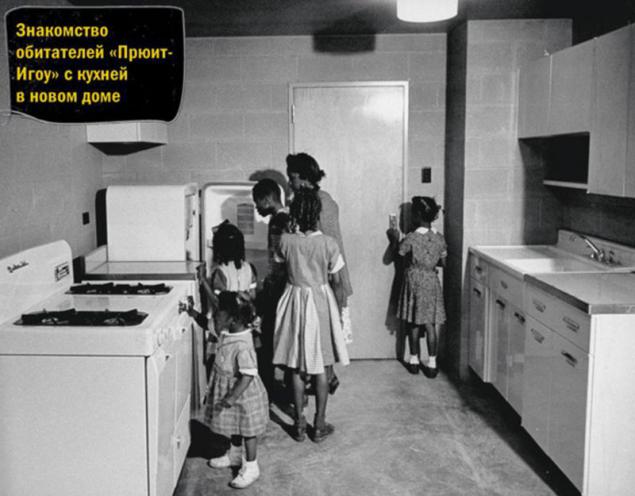
Educated and anything earning blacks, however, also chose not to stay there - their racial solidarity enough to massacre the first two in the entrance.
Of the two regional schools, which belong to the territory of the complex, soon resigned almost all monolingual teachers. It's hard to talk about Hamlet and square roots, when your students for aesthetic purposes openly masturbating on the front desk.

It turned out that in the modern world many of the poor is not the victim of circumstances, and people who do not want to work, as well as to comply with the rule of law and decency. Living among the more successful people, they consciously or unconsciously adapt to the course of life around listlessly, but includes some useful activity, and at the very least, but looking back on the law. And the most idiotic decision would send such people to live in an environment like. Almost instantly it turned into a set of independent fact marginal state where concepts of ownership were worse than those of the Bushmen, where the person who is trying to earn a living honestly treated like Luohu and where violence is valor.

Already in its fifth year of existence of the complex, only 15% of residents have made the minimum rent that was needed for repairs, garbage collection, electricity and water supply. Five years later, the number of paying reduced to 2%.

Small social paradise turned in terrible ghetto USA. 57-year-old Lucy Stounholder that grew in "Pryuit-Igou," says: "The galleries were a place of carnage, there is always loitering teen gangs. Light was nowhere: the bulb broke a few minutes after screwing, as in the dark bands were easier to take care of business. In the elevator, while they still went, committed gang rapes. The freight elevator pushed careless girl or woman to get jammed scum, the elevator stopped between floors, and sometimes raped screams were heard throughout the building is literally for hours. The police arrived only in the daytime, by night they call officially refused, because they could not ensure the safety of its people. Only in rare cases when it was necessary to detain any gang entire commandos stormed one of the towers. During the day you could still appear in the entrance or on the street, but after sunset all tightly locked doors and not stick out of the nose, whatever happens ».
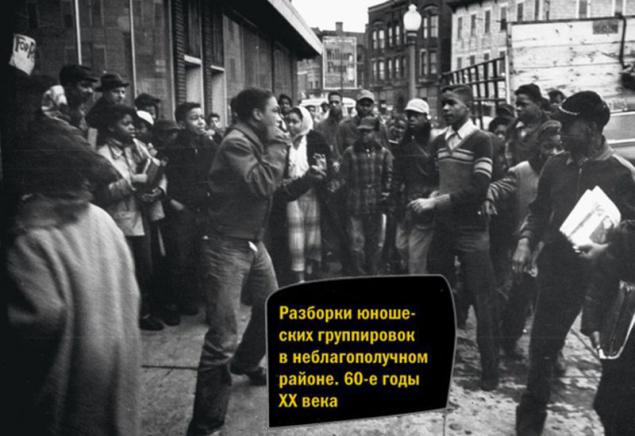
Another "happy" inhabitant of the complex, Ruby Russell in the movie "The Myth" Pryuit-Igou ": urban history," says: "All the common areas have been turned into a field of hostilities. In the morning there fighting children during the day - adolescents, dusk began internecine showdown adult criminal groups. Any unrelated to the crime a person who appeared at least some chance to leave "Pryuit-Igou" ran away. The towers were divided into "good" and "bad." Ours was "good". On some levels, we even had a whole glass, and debris lay not far off in the hallways, and shootings have occurred much less frequently than the "bad" homes. Nevertheless, in our "good" scene of the murder were not uncommon ».
It was during the "Pryuit-Igou" St. Louis took the third place among the most life-threatening US cities (and still it takes). In the mid-60s "Pryuit-Igou" already looks like the perfect place to shoot a zombie apocalypse. Facades gaping broken windows. The area around the house littered with mountains of rubbish - has long refused to serve wipers complex. From top to bottom scribbled obscenities corridors dimly lit lanterns, pick vandal-resistant net. It settles 75% of the total drug in St. Louis, so many staircases can be seen lying gnarled shapes people upolzshih her ugly in his nirvana. It is possible that some of them are dead. The streets here are not prostitutes - it's too dangerous; Local girls go to earn a respectable areas (every third resident of the complex was delayed for prostitution, and every second man had a criminal record). The area stinks terribly; I smell repeated efforts after one of the towers of burst sewers and sewage flooded the building from the roof to the basement.
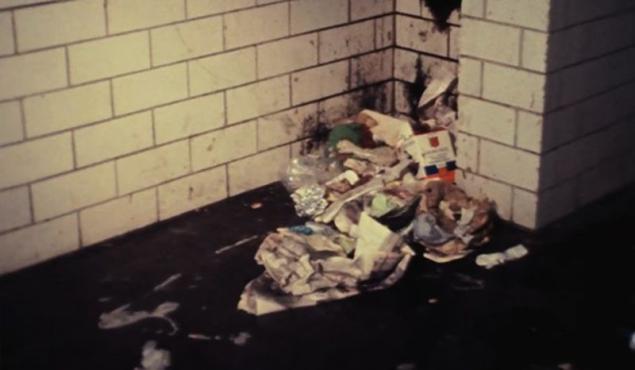
Architect Minoru Yamasaki long been struck from his resume mention of "Pryuit-Igou" - a project that would bring him worldwide fame. Today, with the same success could be to admit that you are the architect of this hell, design all its famous boilers *.
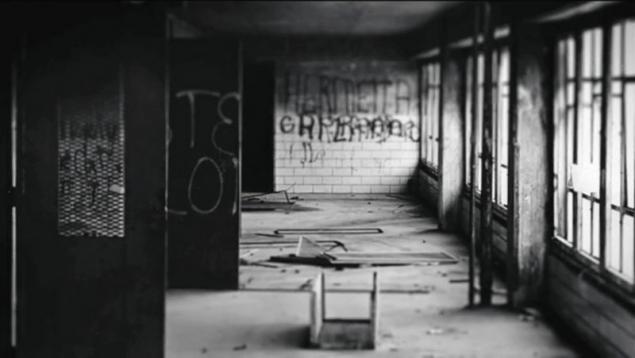
End "Pryuit-Igou»
In 1970, the St. Louis public housing complex "Pryuit-Igou" is officially recognized as a disaster area. Yes, there was no flood or fire or tornado - everything is much worse. None of the projects and the renovation of the salvation of its people is not recognized in the city administration effective. Communications crumbling before our eyes, to carry out repairs and reconstruction of the local context is not possible. And the authorities are taking the only acceptable solution.
Tenants are beginning to settle, directing them to another social housing - usually one or two small houses in a relatively decent area. Then the police and army raids to evict the tower, there catching the homeless and drug addicts, cordon cordoned off the tower, and its blow.
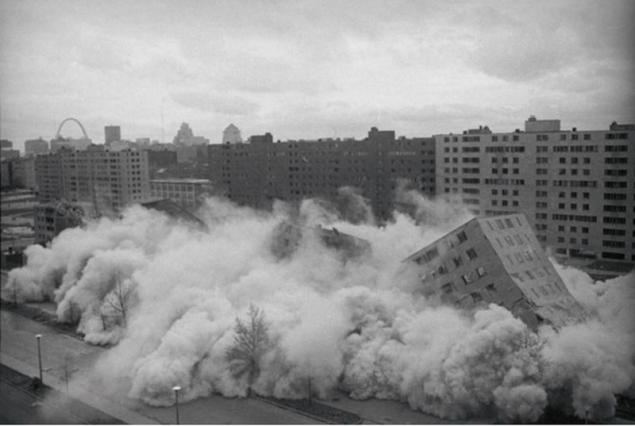
Two years later, "Pryuit-Igou" - a series of pits filled with debris over which hastily sown grass with daisies. A St. Louis now solves the problem of "children Pryuit-Igou." It has dozens of gangs and a few thousand thugs associated with childhood combined experience of survival in the wild is very urban jungle.

That is the problem of social housing complexes made wealthy philanthropists understand that only money and other benefits can not do better than the existence of people, one way or another out of my cultural life. Even compulsory universal education is not a panacea. And only constant contact with carriers of a cultural paradigm can destroy the spirit of the slums, and that this process will be slow, take several generations.
And we, the inhabitants of the country, filled with his "Pryuit-Igou" to prepare for the fact that no oil golden rain for a long time did not change, and the boys with Tyazhmash will continue to pour on vacant lots knuckles before Mahach with boys with Myasomolmasha ... In Generally, in our age of romance enough.
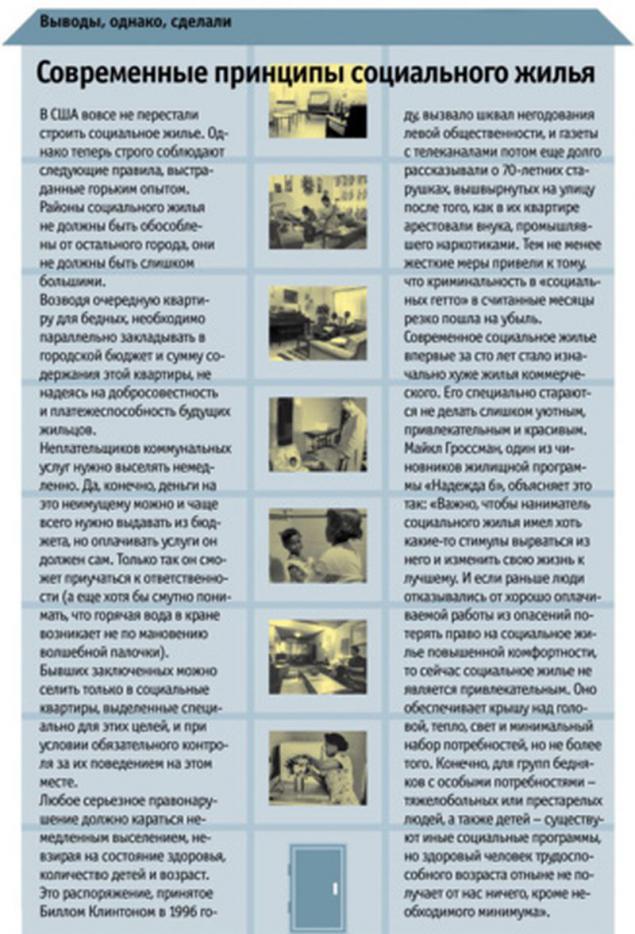
Source: www.maximonline.ru
One of the world's pioneers in the field of mass construction of public housing for the poor were the United States. There is already in the XIX century began to create programs of housing assistance, but the case took seriously only after the Great Depression. President Roosevelt in his "New Deal" paid special attention to the construction of social housing, and in the first half of the 30s, hundreds of thousands of square meters have been made available to the poor - for a nominal rent.
I must say that houses Roosevelt turned out very nice. It was a single family kottedzhiki three or four rooms, with palisadnichkom and backyard, with hot water and a bathroom. They cost a mere penny. To be eligible for social housing rent family had to provide evidence of its complete eradication. Small clerks and well-paid workers wept tears of blood: they were too rich to live there! As a result, an employee or a miner to pay twice as much for the broken-down apartment with a sink on the floor, and the unemployed in this time basking in the hot tub.

Yet for a long time social housing in the United States the average was much better quality housing and commercial. But, of course, at all the poor little cottage is still not enough. Therefore, in the late 40's - early 50-ies of the cottages and townhouses declined. The state began to build a huge complex of social housing - entire neighborhoods with its own infrastructure: roads, hospitals, schools, shops and, of course, high-rise buildings with comfortable and cheap apartments, where the poor devils, and began to move out of the slums.


We wanted the best
One of these systems was the grand project "Pryuit-Igou", created in St. Louis, Missouri. In 1954, he officially opened the doors to many new residents. Thirty-three eleven-house, combined in one zone with recreational green areas around, with small, but comfortable and well-equipped apartments with large areas of common use.

The architect of the project was a young, budding Japanese American Minoru Yamasaki. He has adopted the principles of Le Corbusier: modernity, functionality and comfort. The ground floors of the towers have been set aside for the joint needs of the tenants; there were cellars, bicycle storage, laundry and other services. Each floor had a long and wide gallery, which, according to the author, was to be the area of communication of residents. Here it was planned to hold a party, there were children playing in the rain, then you can just walk around, if you're tired of sitting in the four walls. Shortly before the Missouri was canceled principles of segregation (legally protected separation of white and black population), and the complex was supposed to be not only a symbol of social welfare, but also an outpost of internationalism, tolerance and brotherhood. He was given the name "Pryuit-Igou" - in honor of the hero of the Second World War, black pilot Oliver Pryuita and white member of Congress from Missouri William Igou.
He has managed the whole affair St. Louis $ 36 million - huge money at the time (you can safely multiply by twenty to understand the order of cost).
And in 1954, thousands of poor families from different slums of St. Louis entered the new lovely apartment. The rent was ridiculous. No income, of course, the project was not expected, so tenants pay only for utilities, and even then with a serious discount.

And it turned out ...
"Poverty is contagious" - also wrote Balzac, but the authors of the noble social project, it seems, never thought about the meaning of this warning. Leftist ideas already dominated the educated society, and that the poor man is certainly a victim of a brutal capitalist world, was considered axiomatic.
Feed the hungry, clothe naked, give shelter the homeless - are not these rules should not be mandatory for every decent human being? The history of the second half of the XX century, the century of great social change, has shown that these wonderful rules should be applied only as a preliminary to think about.

After complex "Pryuit-Igou" opened its doors to the poor - single mothers, the elderly lady in straitened circumstances, students from poor families - immediately found out many interesting things:
- It turns out, drinking the unemployed and single mothers are sometimes grown sons, who can not serve as an ornament of society;
- Elderly ladies who find themselves in straitened circumstances, prefer to live at least for bread for the great-nephews, even in the poorhouse, but not where the little son of a single mother zapulivaet their faces smothered by their own cat;
- Students from poor families do not like being raped in an elevator, and students prefer to learn not to lose his teeth, trying to find out who is the toughest in the stairwell.
Soon the white population left "Pryuit-Igou," and now is 99, 8% of the complex was inhabited by black tenants.

Educated and anything earning blacks, however, also chose not to stay there - their racial solidarity enough to massacre the first two in the entrance.
Of the two regional schools, which belong to the territory of the complex, soon resigned almost all monolingual teachers. It's hard to talk about Hamlet and square roots, when your students for aesthetic purposes openly masturbating on the front desk.

It turned out that in the modern world many of the poor is not the victim of circumstances, and people who do not want to work, as well as to comply with the rule of law and decency. Living among the more successful people, they consciously or unconsciously adapt to the course of life around listlessly, but includes some useful activity, and at the very least, but looking back on the law. And the most idiotic decision would send such people to live in an environment like. Almost instantly it turned into a set of independent fact marginal state where concepts of ownership were worse than those of the Bushmen, where the person who is trying to earn a living honestly treated like Luohu and where violence is valor.

Already in its fifth year of existence of the complex, only 15% of residents have made the minimum rent that was needed for repairs, garbage collection, electricity and water supply. Five years later, the number of paying reduced to 2%.

Small social paradise turned in terrible ghetto USA. 57-year-old Lucy Stounholder that grew in "Pryuit-Igou," says: "The galleries were a place of carnage, there is always loitering teen gangs. Light was nowhere: the bulb broke a few minutes after screwing, as in the dark bands were easier to take care of business. In the elevator, while they still went, committed gang rapes. The freight elevator pushed careless girl or woman to get jammed scum, the elevator stopped between floors, and sometimes raped screams were heard throughout the building is literally for hours. The police arrived only in the daytime, by night they call officially refused, because they could not ensure the safety of its people. Only in rare cases when it was necessary to detain any gang entire commandos stormed one of the towers. During the day you could still appear in the entrance or on the street, but after sunset all tightly locked doors and not stick out of the nose, whatever happens ».

Another "happy" inhabitant of the complex, Ruby Russell in the movie "The Myth" Pryuit-Igou ": urban history," says: "All the common areas have been turned into a field of hostilities. In the morning there fighting children during the day - adolescents, dusk began internecine showdown adult criminal groups. Any unrelated to the crime a person who appeared at least some chance to leave "Pryuit-Igou" ran away. The towers were divided into "good" and "bad." Ours was "good". On some levels, we even had a whole glass, and debris lay not far off in the hallways, and shootings have occurred much less frequently than the "bad" homes. Nevertheless, in our "good" scene of the murder were not uncommon ».
It was during the "Pryuit-Igou" St. Louis took the third place among the most life-threatening US cities (and still it takes). In the mid-60s "Pryuit-Igou" already looks like the perfect place to shoot a zombie apocalypse. Facades gaping broken windows. The area around the house littered with mountains of rubbish - has long refused to serve wipers complex. From top to bottom scribbled obscenities corridors dimly lit lanterns, pick vandal-resistant net. It settles 75% of the total drug in St. Louis, so many staircases can be seen lying gnarled shapes people upolzshih her ugly in his nirvana. It is possible that some of them are dead. The streets here are not prostitutes - it's too dangerous; Local girls go to earn a respectable areas (every third resident of the complex was delayed for prostitution, and every second man had a criminal record). The area stinks terribly; I smell repeated efforts after one of the towers of burst sewers and sewage flooded the building from the roof to the basement.

Architect Minoru Yamasaki long been struck from his resume mention of "Pryuit-Igou" - a project that would bring him worldwide fame. Today, with the same success could be to admit that you are the architect of this hell, design all its famous boilers *.

End "Pryuit-Igou»
In 1970, the St. Louis public housing complex "Pryuit-Igou" is officially recognized as a disaster area. Yes, there was no flood or fire or tornado - everything is much worse. None of the projects and the renovation of the salvation of its people is not recognized in the city administration effective. Communications crumbling before our eyes, to carry out repairs and reconstruction of the local context is not possible. And the authorities are taking the only acceptable solution.
Tenants are beginning to settle, directing them to another social housing - usually one or two small houses in a relatively decent area. Then the police and army raids to evict the tower, there catching the homeless and drug addicts, cordon cordoned off the tower, and its blow.

Two years later, "Pryuit-Igou" - a series of pits filled with debris over which hastily sown grass with daisies. A St. Louis now solves the problem of "children Pryuit-Igou." It has dozens of gangs and a few thousand thugs associated with childhood combined experience of survival in the wild is very urban jungle.

That is the problem of social housing complexes made wealthy philanthropists understand that only money and other benefits can not do better than the existence of people, one way or another out of my cultural life. Even compulsory universal education is not a panacea. And only constant contact with carriers of a cultural paradigm can destroy the spirit of the slums, and that this process will be slow, take several generations.
And we, the inhabitants of the country, filled with his "Pryuit-Igou" to prepare for the fact that no oil golden rain for a long time did not change, and the boys with Tyazhmash will continue to pour on vacant lots knuckles before Mahach with boys with Myasomolmasha ... In Generally, in our age of romance enough.

Source: www.maximonline.ru












